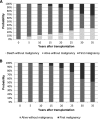Long-Term Risk of Cancer in Survivors of Pediatric ESRD
- PMID: 26430089
- PMCID: PMC4670765
- DOI: 10.2215/CJN.03630415
Long-Term Risk of Cancer in Survivors of Pediatric ESRD
Abstract
Background and objectives: ESRD is associated with an increased risk of malignancies. We analyzed the incidence of cancer in patients with pediatric ESRD after long-term follow-up.
Design, setting, participants, & measurements: All Dutch patients born before 1979 who were transplanted at age <15 years old in 1972-1992 were followed until 2010. We explored type and incidence of malignancies in patients compared with the general population using the National Cancer Registry.
Results: After a median of 25.3 years (1.3-37.8) of transplantation and at a median age of 33.5 years old (11.0-49.0), 105 primary malignancies had occurred in 54 of 249 patients. Among them, cutaneous squamous cell carcinoma was most frequent. Patients ages 25-30 years old had developed 16.5 times (95% confidence interval, 7.9 to 34.6) as many de novo tumors and 991 times (95% confidence interval, 313 to 3137) as many de novo cutaneous squamous cell carcinomas as their general population counterparts; in survivors ages 45-50 years old, these numbers were 81.5 (95% confidence interval, 50.7 to 131.1) and 2610 (95% confidence interval, 1596 to 4267), respectively. Cumulative incidence competing risk analysis showed that, after 30 years of transplantation, 41% of the survivors had developed cancer; 31% had developed a second de novo cancer <1 year after initial cancer diagnosis.
Conclusions: Cancer is highly prevalent among patients with pediatric ESRD after 25.3 years of transplantation, with a high rate of recurrence.
Keywords: cancer; carcinoma; child; end-stage renal disease; follow-up studies; kidney failure, chronic; neoplasms; renal insufficiency, chronic; renal transplantation; squamous cell; survivors.
Copyright © 2015 by the American Society of Nephrology.
Figures


References
-
- Centraal Bureau voor de Statistiek : Statistics Netherlands. Available at: http://www.cbs.nl. Accessed February 8, 2015
-
- Holley JL: Screening, diagnosis, and treatment of cancer in long-term dialysis patients. Clin J Am Soc Nephrol 2: 604–610, 2007 - PubMed
-
- Port FK, Ragheb NE, Schwartz AG, Hawthorne VM: Neoplasms in dialysis patients: A population-based study. Am J Kidney Dis 14: 119–123, 1989 - PubMed
-
- Birkeland SA, Løkkegaard H, Storm HH: Cancer risk in patients on dialysis and after renal transplantation. Lancet 355: 1886–1887, 2000 - PubMed
-
- Vajdic CM, McDonald SP, McCredie MR, van Leeuwen MT, Stewart JH, Law M, Chapman JR, Webster AC, Kaldor JM, Grulich AE: Cancer incidence before and after kidney transplantation. JAMA 296: 2823–2831, 2006 - PubMed
Publication types
MeSH terms
LinkOut - more resources
Full Text Sources
Medical

